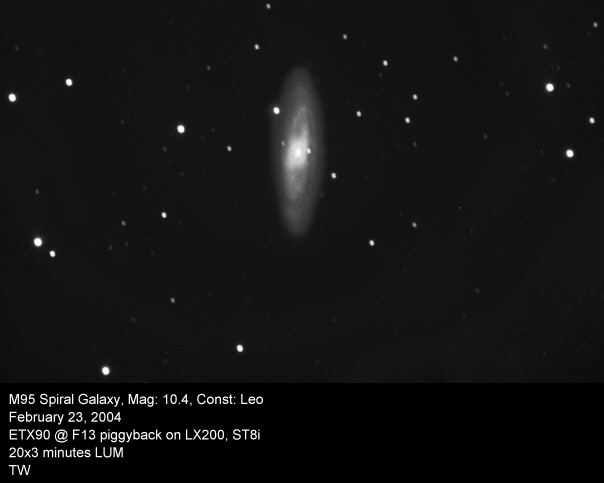| 2/24/04:
I've been trying to use the
90 piggyback on the LX200 for
guiding. The results were poor, with
most images showing elongation and
significant guiding problems. I
thought that perhaps there was some
movement or flexure when using the
eyepiece hole on the scope and that
attaching to the back might help
improve things in that area. I
found a visual back for the ETX90 at
Scopetronix that was just the ticket.
They also had an F7 focal reducer
built into a visual back. This is an
interesting possibility: an ST8i on
an ETX90 at F7 has a wide 50x75
arcmin FOV and a forgiving image
scale near 3 arcsec/pixel. This is a
nice size for many objects that are
just too big for the ST8 on the
LX200. I've been wanting a wide field
scope for a while and am still
thinking about purchasing one of the
new Orion 80mm F7.5 apos.
The
characteristics of the F7 ETX90 are
even better than the apo, except for
the central obstruction. The ETX90
has a nice Mak design with good focus
and contrast, 90mm aperture vs 80,
and it's faster at F7 vs F7.5. And to
guide at F13, all I have to do is
replace the focal reducer with the
visual back, no swapping guide scope
and wide field scopes! One more
thing, the ETX90 has a built in flip
mirror, so a star can be located
manually with an eyepiece without
ever having to move the camera or
refocus. That's a very nice feature
for a guide scope.
Overall
it looked too good to pass up so I
purchased a visual back and a focal
reducer. I tried the reducer when it
arrived and got terrible results. It
was as if the optics were pinched.
When focused, here's what the images
were like:

Not
good! I decided to try just the
visual back and that worked well. I
was able to achieve critical focus
and ripped off a few 3 minute
unguided shots of M65.

So,
the visual back enabled the ST8i and
color filter wheel to reach focus and
take a series of good unguided shots,
but the focal reducer didn't work at
all. It's possible that the camera is
flexing, I'm going to shim it with
cloth or styrofoam or something to
take any strain out of the system to
see if that makes a difference. I'm
also going to try some daytime shots
to see what they look like. If it
doesn't work, I'll ask Scopetronix if
they've ever had someone successfully
use this setup, perhaps this combo
just doesn't work.
In
addition, I still need to try guiding
at F13 to see if the new visual back
helps with the guiding results. Since
the LX200 is producing good images
unguided, there has to be some
movement somewhere causing the poor
guiding results. I suspect that the
guide camera was moving around in the
eyepiece port, I'm hoping the visual
back helps me lock it down.
|